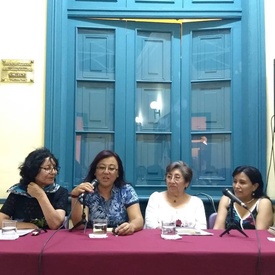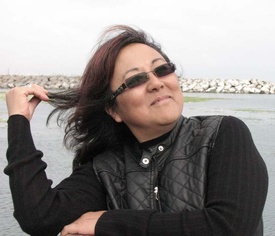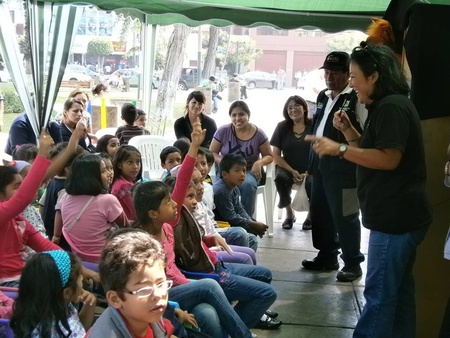There is no word that serves to define Doris Moromisato Miasato (Chambala, 1962), one of the most unique writers and Nikkeis in Peru. Equipped with a voice capable of saying what she thinks, even when what she thinks is not the most popular or socially accepted, she has managed to earn a name in the world of Peruvian literature through poetry, but she has struggled not to be pigeonholed into that facet that began in 1988 with the collection of poems “Abode where the moon lost its paleness.”
Her first approach to literature was through journalism, at the end of the 1980s, thanks to fellow journalist Martha Meier Miró Quesada, “my great friend and who taught me the ethical exercise of journalism: serving those who have no voice.” , to those who cannot communicate, and show the human and fragile side of the news; That is why I admire her and she is for me a reference of journalistic fortitude and integrity.”
This is how Doris began a career in which she learned everything that surrounds the press and media industry, and where she met people who taught her the gift of words: writing correctly about people and issues. of daily life was the lesson left to him, among others, by the Nikkei journalist and also bullfighter, Ricardo Mitsuya Higa.
“He was another person who marked me, especially in the Nikkei sphere. I have a great friendship with Ricardo; As a person he is a generous and helpful being, as a journalist he was incredible: he wrote all his notes and chronicles by hand, I was always impressed by his concentration and dedication when he picked up a pen and wrote in neat and illustrated Spanish," says Doris, whose poems have been included in a couple of anthologies.
free letters
From a very young age, Doris Moromisato met renowned journalists, writers and intellectuals in Peru, whom she remembers and summarizes in one or two words: from Alejandro Sakuda, the dynamism, from Enrique Higa, the efficiency; from Alfredo Kato, fun, from Ricardo Mitsuya Higa, total journalism, from Patricia Uehara, the absolutely social, from José Watanabe, serenity; by Augusto Higa, the memory of the neighborhood. For Doris, a word that can help summarize her is commitment.
In 2003, she assumed the position of cultural director of the Peruvian Chamber of Books (CPL), the institution in charge of organizing, among other tasks, the International Book Fair, a task that she carried out for eleven years. “Cultural management is the best thing that has happened to me,” says Doris, “I have a law degree, but I hate the practice of law. I love being a cultural manager, since her practice ranges from making books to organizing events with artistic manifestations.”

From that position he sought to innovate in the promotion of reading to make the book “a territory of good news in our country,” as he once wrote. “Cultural management involves creativity, sense of smell, marketing, diplomacy, economics, generosity and democratic values,” thinks Doris, who believes that Japanese responsibility and discipline have been characteristics for which it has been noted in the cultural environment.
Active activist

But we said that pigeonholing Doris Moromisato is difficult, and this is evident in her literary work, which led her to write the book on Japanese immigration “Okinawa: a century in Peru” (2006), co-authored with Juan Shimabukuro Inami; and “The second look. Memory of the Simone de Beauvoir colloquium and gender studies” (2008), one of her forays into the territory of feminism, where she is now an active activist, in addition to getting involved in other causes such as environmentalism.
She dedicated a poem to the archaeologist María Reiche and another to the social activist María Elena Moyano. She worked with the Flora Tristán Peruvian Women's Center, which published her collection of poems “Diario de la mujer es ponja” (2004), which addresses themes such as identity, sexuality and culture, which was followed by “Landscape” (2007), with an emphasis on ecology, and with which he announced his retirement from poetry. “The poet in me will go into hibernation,” she said in an interview 1 .
The writer Oswaldo Reynoso defined her as “a human being that vibrates” 2 . Among the winds that move Doris are gender studies, the promotion of women's culture and cultural management. “Art and culture are political proposals,” she said in another interview 3 , where her interviewer describes her as a gale, one who participates in poetry recitals, gives lectures, and collaborates with young students. “That is a very Okinawan characteristic related to hospitality, solidarity and joy.”
Back to Nikkei
Doris has been a bibliographer at the Museum of Japanese Immigration to Peru and has investigated the Nikkei community as a symbolic, cultural and artistic construction, a topic to which she returns as if returning to the starting point. His parents were born in Okinawa and migrated to Peru where they had eleven children. She was the last, which allowed her to grow more freely, without separating herself from her oriental origin.
“The entire Japanese and Okinawan symbolic universe forged my personality, marked and will mark all my literary works,” says Doris, who recently participated in a round table on Japanese immigration at the Peruvian Japanese Cultural Center, which brings together a Nikkei community that for her “It is very well built, it has a fabric made by its members themselves, so it is very difficult for it to deteriorate.”
This continuity in the messages, together with “the complicity built from generation to generation,” means that the experience of the first immigrants is perceived as something very close to the last generations of Nikkeis, says Doris Moromisato. “As long as both parties, the oldest and the most modern, feel reciprocated, I think the opportunities will continue to exist in our community.”
New Times
For Doris Moromisato, current times are dominated by the speed and banality of digital media and social networks. “Everything happens quickly and nothing remains, neither the news nor the technological formats. Banality consists of the fact that the media (supports) have supplanted the ultimate goal (the event): the news, now, is the supports themselves and not what the supports should report. Incredible but true".
In this context, he founded, in 2011, Kimochi Gestión Cultural, an initiative to carry out cultural programs, projects or activities that promote sustainable human development, gender equality, citizen organization and support for the environment and peace, among other objectives, while continuing with his literary career which he seeks to direct along the path of narrative.
“What word will I write to conjure the future?” says one of his poems. The writer, poet, activist, leftist, feminist, environmentalist, San Marcos, cultural manager, Okinawan, Peruvian, Buddhist and cat lover has more than one word to feel free in her accelerated journey through Peruvian literature and the Nikkei community, the The same one that in 2019 has given him two spaces to disseminate his literary work and hear his voice, as clear and free as in its beginnings.
Grades:
1. Nako Fuentes, Harumi and Peruvian Japanese Association, “ Doris Moromisato: 'The poet in me will go into hibernation' ”, Discover the Nikkei. (May 6, 2008)
2. “ Doris Moromisato presented electronic book ”, Peru Shimpo (November 13, 2013)
3. “Interview with Doris Moromisato ”, iqt newspaper (July 30, 2006)
© 2019 Javier García Wong-Kit








